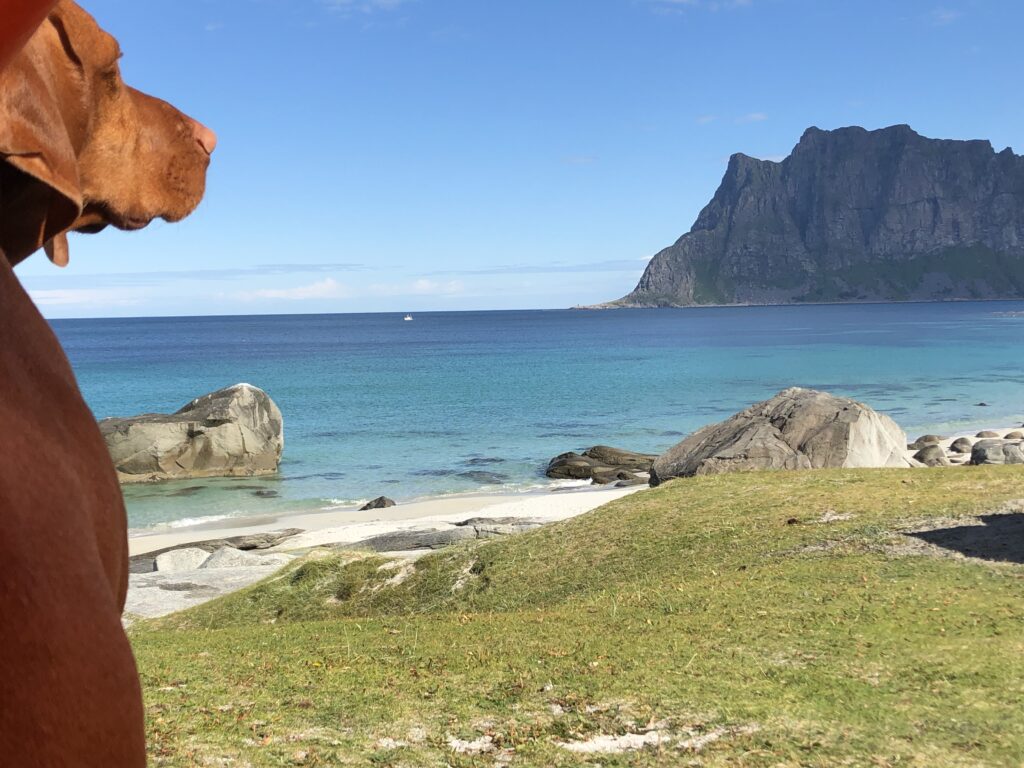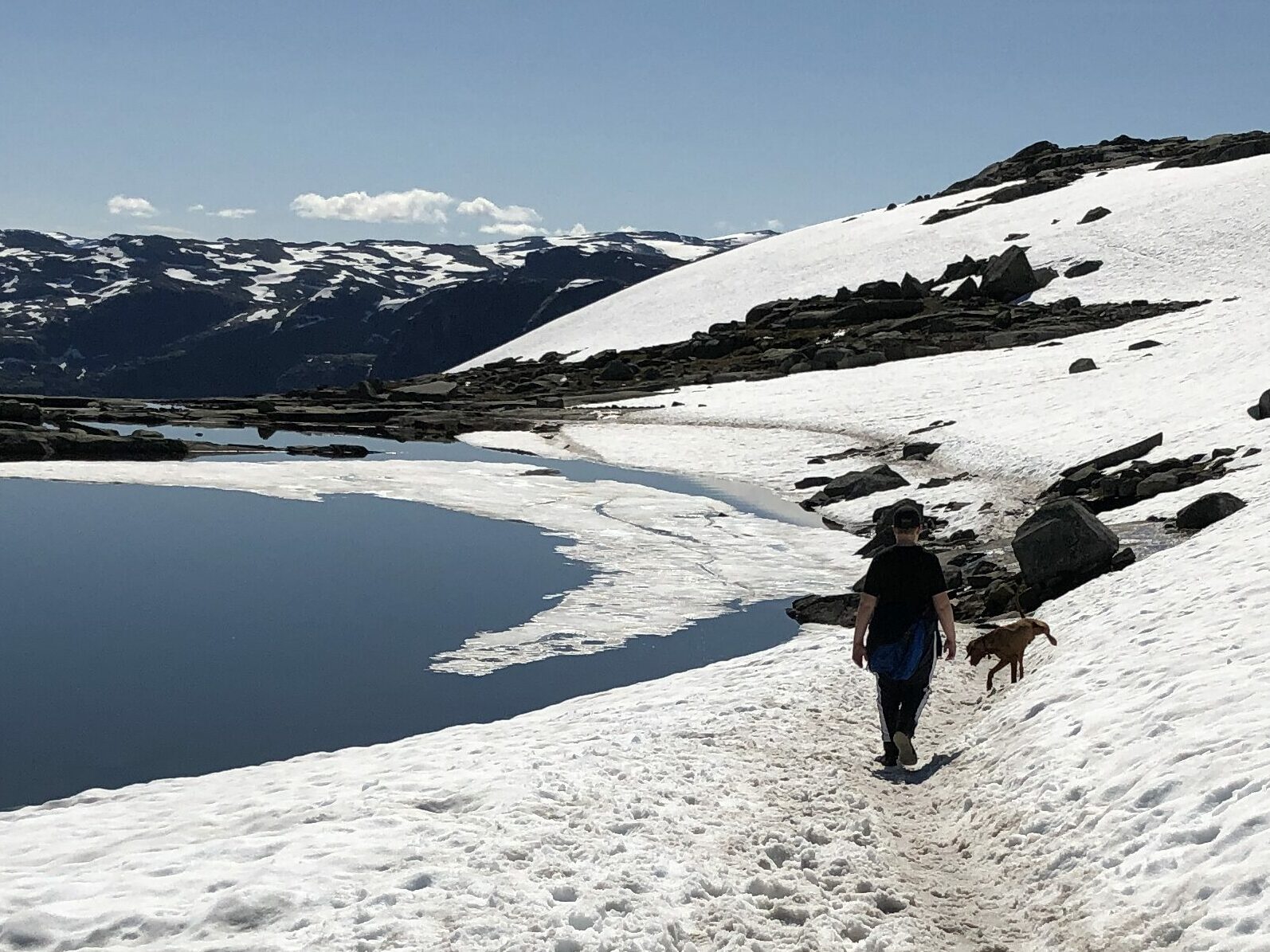Norway has the most beautiful nature in Europe. Its untouched wilderness, spectacular archipelagos and picturesque fjords make it a worthy pilgrimage. Norway can be cold though, even in the summer – expect daytime temperatures of 6°C to 9°C in the north and 12°C to 25°C in the south.
The best way to see Norway is by car or motorcycle between the months of June and September. It’s possible to visit in the winter, but that brings its own complexity. Norway’s roads become ice free during the Spring. Roads at high altitude and in the north take the longest with the southern coastal regions being the first to thaw.
Driving in Norway
As the bird flies, the coastline is around 2500 km long but with all the windy fjords you are likely to clock closer to 5000 km. Driving 250 km a day is comfortable – that’s about 4 hours of driving. Factor also in frequent ferry crossings which can take 30 to 60 minutes each with waiting times.
It is possible to opt for tunnels sometimes if you want to get somewhere faster. They cut through mountains and under the fjords and are feats of engineering. One particular tunnel of note is the Lærdal Tunnel which is the world’s longest road tunnel, coming in at 24.5 km long.
You will see a lot of Motorhomes in Norway. Often the people driving them are less skilled and it can be difficult to pass so you need a bit of patience.
There are plenty of Petrol stations around in most of the built up areas. A good rule of thumb is to not let the tank get below 1/4 full just in case. The further south you go the cheaper the fuel gets. Prices are on par with other northern European countries.
Factor in what you will need to pay in ferries and tolls. If you are crossing the whole country that could be anywhere between €150 and €200, not including the more expensive fjord car ferries. Annoyingly each region has its own way of collecting tolls and sometimes the only option is with an electronic account. Cash or card is not an option in some places.
What to See
The most scenic parts of Norway are in Western and Northern Norway. If you want to see it all you need 3-4 weeks.
The north has the most rugged scenery and prettiest archipelagos especially around Lofoten. It’s more isolated and peaceful as fewer people visit the north.
Western Norway has all the big fjords, massive waterfalls and famous hikes like Trolltunga, Pulpit Rock and Kjerag. If you are pushed for time you can see a lot it in 1 or 2 weeks by stick to a 380 km radius of Oslo.
Western Norway sample itinerary: Trollstigen, Atlanterhavsveien, Alesund, Geiranger, Loen, Nærøyfjord Bergen, Odda (if you want to hike Trolltunga), Stravanger, and Lysefjord.
Northern Norway sample itinerary: Nordkapp, Alta, Tromsø, Senja, Andøya, Lofoten and Bodø.
Google maps has got a ton of information on waterfalls and other scenic spots along the way between those places. Be sure to also do as many scenic fjord ferries as you can afford especially around Geiranger, Nærøyfjord and Lysefjord.
If you get time to check out the highlands, Jotunheimen National Park should be on the top of your list. It is located in the top of Eastern Norway. Glittertind is the tallest mountain within the park and also Northern Europe standing at 2452 m.
Accommodation
 View from our tent door – Uttakleiv Beach
View from our tent door – Uttakleiv Beach
Camping: Free camping is an easy option in Norway, especially in the north. It is easy to find places to set up camp that don’t bother anyone. A better option can be to pay around €20 per tent site at a camp ground. For that you get fresh water, hot showers, flushing toilets and a warm kitchen to cook in which can be helpful if the weather turns nasty. It is usually easy to finding available camp sites, even at the last minute.
Huts: Most camp sites have basic wooden huts that go for between €50 – €70 a night. They are heated but usually don’t have toilets or running water and you need to bring your own bedding. These Huts go quickly and you probably won’t get one unless you book a few days in advance.
For both camping and huts you can use the apps Norcamp and Camping.no which have the prices locations and contact details.
Cabins and Private Rooms: Most of these rented by private individuals and they don’t come cheap. Expect to pay north of €150 a night unless you manage to get a good deal in advance. There is always more demand than supply in the summer months. The usual Booking.com and Airbnb are the best sites to find these places.
Hotels: Unless you are near the bigger towns or ski resorts you won’t find too many hotels. Booking.com is still a good site to see what is available.
Food
Food will be one of your biggest expenses in Norway. There are supermarkets all over the country but the further north you go the smaller they get. In some remote areas like Nordkapp you have to drive 30 km to find a shop.
Restaurants and cafes are common around the big towns but you can be hard pressed to find so much as a kebab shop in some places. On the well beaten tourist trails it is a bit easier. Whatever the case, always have a few cans in the car in case you get stuck.
Hiking
Norway has a lot of hikes that are very demanding. Common distances are between 15 – 30 km with challenging assents and descents of several thousand meters. What’s more, it is common to be trekking through snow, mud or water which can zap your energy.
Norwegians don’t believe in setting up barricades to stop you falling to your death so stick to the tracks. Bad weather can set in with very little notice and it is not uncommon to be walking at times in zero visibility. Cell coverage is patchy or non existent when you move up into the mountains. Expect your devices to go flat so have paper backups.
Make sure you have proper gear, especially clothes to protect you from the wind and rain. Hypothermia is a real risk that needs to be managed, especially if you are not moving. Your feet will get wet, regardless of how waterproof your shoes are so invest in good socks that protect you from blisters.
 Trolltunga hike in July
Trolltunga hike in July
Stay hydrated. It is usually possible to find water along the way which is necessary on the longer trails. Drinking from moving streams is less risky than from still water. The less weight you carry the higher your chances are of making it.
Check out the Norwegian app Outtt for information on hikes. Ut.no which is owned by the Norwegian trekking association is also a great resource.
Make sure you have insurance if you run into trouble. I recommend joining the Austrian Alpine club as membership is only £57 a year and it includes free helicopter rescue if you run into trouble.
Conclusion
Norway is incredible and well worth a visit. It is an expensive place to visit but if you stick to camping and supermarkets it may not break your bank account. Spend some time doing thorough research and it will pay dividends. Most of the info can be easily found on Google maps or on the sites I have mentioned above. Prepare well for your hikes and make sure you have insurance if you run into trouble. Stay safe and have fun!